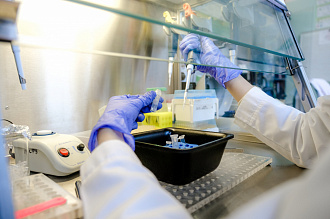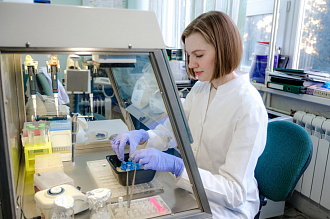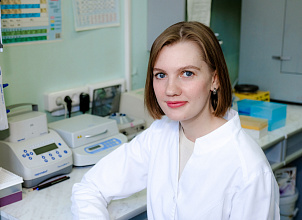Presidential grant recipient was attracted to science by its beauty
22 March 2021 г.

Evgenia Bashmakova is developing a bioluminescent immunoassay to identify a protein which is associated with the risk of developing melanoma. It was in order to support this research for two years that the Presidential grant was allocated in 2019.
“There are no Russian systems for identifying some oncoproteins, for example, a protein with melanoma-inhibiting activity,” the scientist explains. "And this is a very important tumor marker, and thus, we are now conducting research to create a highly sensitive method for its identification."
In the course of the experiments, together with her colleagues, Evgenia is developing new effective methods for analyzing various important compounds for the diagnosis of diseases, including cancer, using luminous proteins.
“We work with bioluminescent proteins, in particular, with a protein of hydroid polyp Obelia longissimi the photoprotein obelin. We obtain these proteins in the laboratory, where they are synthesized using E. coli. We take a sample in which we need to find the object of interest. For example, the object, so-called "target", can be a particular oncoprotein or tumor cell. We introduce our luminous protein into the sample in order to reveal the “target”, - says Evgenia Bashmakova.
According to the researcher, the glowing protein itself is not able to bind to any "targets." To do this, it must be modified, that is, combined with a molecule, for example, with an antibody or aptamer, which is capable of recognizing the “target”. It is the aptamer or antibody, previously bound to the protein obelin, that "binds" to the oncoprotein and thus, helps to identify it. And with the addition of calcium the glow makes the cancer cells visible.
Predicting illnesses and choosing treatment
The direction in which the scientist has been working for more than 7 years is promising from the view point of applied medicine.
As early as in 2017, Evgenia Bashmakova received a grant as a graduate student, under the program “Umnik”, and she conducted research aimed at developing a method for early detection of lung cancer based on bioluminescent analysis.
Over the next five years, Evgenia, along with colleagues from Krasnoyarsk and Moscow, participated in an extensive study to identify genetic mutations associated with a predisposition to melanoma.
Based on bioluminescent reporters, an analysis was developed which can be used to determine the susceptibility to any disease associated with genetic mutations. Often, identifying mutations helps doctors correctly predict the course of the disease and choose the most effective treatment. But so far these diagnostic methods have not been widely used in medicine, since they still have to undergo laboratory and clinical studies.
Science on the one hand, beauty on the other
Share:



